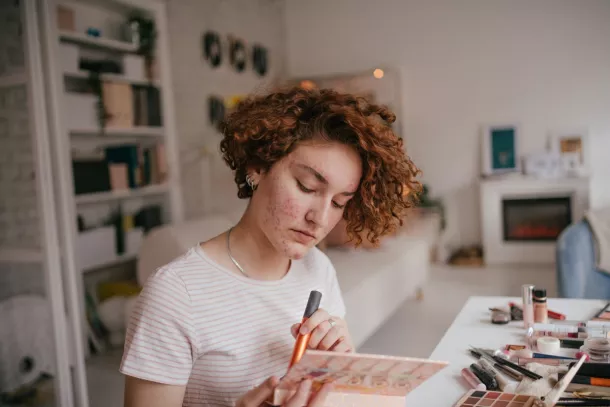
©Getty Images/Aleksandar Nakic
Acne is an inflammatory skin condition that many people experience Associates pimples in adolescents during puberty. But there are many different types of disease. These include acne tarda, known as acne of old age, neonatal acne, cystic acne, and the frequently occurring acne vulgaris. How does acne develop and where on the body can it appear? When can creams, tablets, or home remedies help, and what other treatment options are there? You can learn more about this below.
What is Acne?
Acne (also called acne) is a group of inflammatory skin diseases, usually originating from an overactive sebaceous gland or excessive skin cell formation. It is characterized by sometimes painful blackheads and pimples on various parts of the body and occurs particularly frequently due to hormonal disturbances. The most common form is the so-called acne vulgaris (also common acne or adolescent acne).
Causes: How does acne develop?
The cause of the formation of painful pimples is usually an overproduction of sebum (seborrhea).
The excess sebum collects in the hair follicles of the skin (i.e. in the ducts where hair grows and which are adjacent to the sebaceous glands) and initially small bumps (comedones/blackheads) form. An increased formation of skin cells that settle on top of the hair follicle and close it (so-called cornification occurs) can also lead to the formation of black dots.
If the pressure in the hair follicle is too high due to the accumulated contents, it bursts and releases its contents as a whitish secretion on the skin. Now there is an open blackhead in place of the pimple. The natural skin barrier is now disturbed. This allows bacteria present on the skin or carried on the face by dirt to enter.
Colonization with the bacteria causes the area to become inflamed, red, and painful. There is also talk of the so-called pus pimples. These heal less quickly than their precursors. In severe cases, they can penetrate deep into the skin (abscess formation) and cause scarring.
What types of acne are there?
Depending on the cause, there are different types of acne. It is important to know whether the cause of the skin disease comes from the outside (exogenous) or from the inside (endogenous). Exogenous acne usually has a clear cause, while endogenous forms are multifactorial (due to many causes).
endogenous acne
Endogenous acne is mainly caused by a change in the hormonal balance, which stimulates the production of sebum. The form, which is therefore also known as hormonal acne, usually presents as acne vulgaris (adolescent acne) during puberty, but can also occur at other stages in life.
A distinction is made between acne neonatorum (neonatal acne) in infants, acne infantarum (infantile acne) and acne tarda in adults (acne tardive, acne of old age or adult acne).
Cystic acne is also caused by a hormonal imbalance. It differs from other endogenous forms in the severity of symptoms. They form deep in the skin Cysts, which are also found on the cheeks and chin and are usually more difficult to treat.
Exogenous acne
External influences such as skin care products, medications or chemicals can also cause the typical acne symptoms in some people:
- Acne aestivalis (Mallorca acne): This type of acne develops on areas of the body that are exposed to light. The cause is a reaction of fat on the skin’s surface or fat-containing sunscreens to sunlight.
- Acne venenata (contact acne): Acne venenata occurs when the skin comes into contact with a specific trigger (such as chlorine). This also includes the so-called cosmetic acne, in which the skin reacts to contact with make-up or other products.
Other types and designations
Acne inversa is an intermediate form, in which pimples appear mainly on the genitals and armpits. The causes have not yet been clarified beyond doubt. What is certain, however, is that the disease is a consequence of hormonal disturbances or immune deficiencies (immune system alterations), but can also be triggered by external factors.
In addition, several forms of the disease are distinguished, such as comedonal acne, which is mainly characterized by blackheads, papulopustular acne, which is associated with papules, pustules and inflammation, and acne conglobata, which is characterized by deep inflammation and nodules.
Due to similar symptoms, some other skin diseases are also called acne, although they do not belong to this group. These include, for example, fungal acne (a fungal skin disease) and acne rosacea (the cause of which has not yet been clarified).
What are the symptoms of acne?
Acne is usually characterized by typical signs:
- Main symptom: comedones (blackheads) and pimples on the face (especially on the forehead, nose, cheeks and chin), back or chest, rarely in the armpits or genital area
- pimples both closed and open, partially inflamed (then painful and red)
- the formation of inflammatory pustules and abscesses is possible
- Scar formation in severe courses
- further symptoms (e.g. fever) are rare and occur only in severe forms
Treatment: what helps against acne?
The treatment of acne always depends on the current complexion of the affected person and the triggers of the skin disease. The following skin care tips may help:
- In general, daily and thorough cleaning of the affected areas should be ensured.
- Peels and non-comedogenic products (skin care products without ingredients that promote the formation of blackheads) as well as suitable moisturizers can promote faster healing and protect against painful inflammations. Examples of comedogenic ingredients in cosmetics include cocoa butter, olive oil and acetylated wool alcohol (lanolin alcohol).
- Even home remedies can help against blemishes. For example, the anti-inflammatory effect of chamomile flowers or honey is used.
If you have mild acne, this may be enough to relieve your symptoms.
A healthy and balanced diet can prevent the formation of acne. In some cases, a clearer complexion and reduced sebum production can be achieved through adequate intake of vitamins and fiber, as well as reduced consumption of sugar, fat and other stimulants (e.g. coffee).
Squeezing acne pimples should be avoided in any case. This opens up the blackhead and increases the risk of inflammation. There is also an increased risk that the skin will not fully recover and that scarring will form. In rare cases, an ascending infection can also lead to inflammation of the meninges.
In general, a dermatologist (dermatologist) should always be consulted in the event of new or suddenly worsening acne in order to clarify the cause and develop an individual therapy concept.
drug treatment
Drug therapy is divided into two groups and differ in how they are used. There are acne remedies that are applied externally and medicines that work from within.
TO light to moderate forms Topical products (applied topically to the skin) are initially used to treat acne. These are available, for example, in the form of ointments or gels and are applied directly to the affected areas. These creams often contain so-called retinoids (vitamin A), which support the healing of blackheads and have an anti-inflammatory effect. The active ingredients benzoyl peroxide or azelaic acid are also used in many preparations.
TO severe acne systemic therapy with prescription tablets may be required. Compress therapy is also often used for large events, such as acne on the back and in the décolleté area. The active ingredients derived from vitamin A are also used systemically.
For severely inflamed skin areas, treatment with antibiotics may be necessary. These drugs have an antibacterial and anti-inflammatory effect and are intended to facilitate the healing of the pimple and prevent painful progression.
dating women moderate to severe hormonal acne suffer, they have the opportunity to combat it by taking so-called anti-androgen agents (e.g. spironolactone). This reduces the production of certain hormones that promote the formation of pimples on the face. For this the pill (birth control pill) can also help against acne.
Updated: 06/14/2023
Author: Nathalie Wagner, human medicine student




